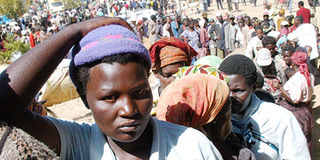45,000 need food relief as rains fail

Women queue for relief food. A new government report has indicated that over 45, 000 people are in need for releif food following shortage of rains. PHOTO/ FILE
More than 45,000 people in Taita and Taveta districts are facing starvation as short rains failed, a Government report says.
The document, prepared by the Ministry of Northern Kenya and Arid Lands, says residents would be put on the food-for-work programme because of the gravity of the situation.
The report warns that the number of people affected was likely to rise after the short rains that were expected to start in September failed.
“An assessment by the ministry has revealed that the lowlands of Taita district and rain-fed areas of Taveta district have shown indicators of severe food stress, with household members appealing to the Government and non-governmental organisations for assistance through food for work or general relief distribution,” the report says.
Starvation
Of the 45,000 people facing starvation in the region, 30,000 are from Taita District while 15,000 are from Taveta District.
The region’s drought management officer Mustafa Parkolwa said hard hit areas in Taita district required immediate attention.
They include Maktau in Mwatate division, Kasigau and lower Sagalla in Voi division and Tausa in Mwambirwa division.
“Although pasture and forage is still available in the lowlands of the two districts, their quality and quantity is deteriorating at a high rate compared to previous months when it was still wet,” he said.
Most affected
Challa Kati, Mata, Vikwatani and Chumvini are some of the most affected areas in Taveta.
Mr Parkolwa said both districts faced many challenges ranging from poor rainfall to crop destruction by wildlife.
He said elephants were destroying food crops under irrigation and water conservation infrastructure.
Mr Parkolwa said hippos, wild pigs, baboons and monkeys were also posing a serious threat to farmers.
He said that although food was available on the market, prices of cereals and legumes had almost doubled, making it difficult for the local residents to afford.




